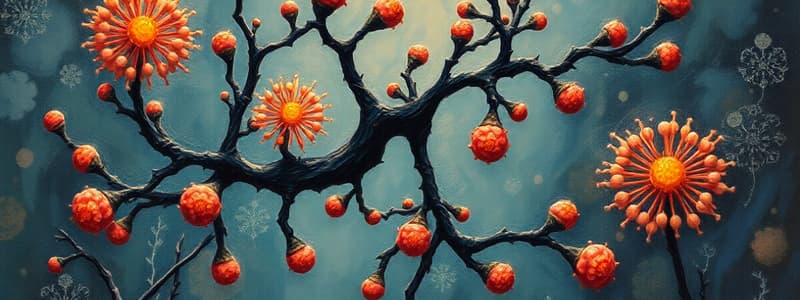Podcast
Questions and Answers
What is the correct order of levels of functional organization in living beings?
What is the correct order of levels of functional organization in living beings?
- Cells, tissues, organs, systems, organisms (correct)
- Cells, tissues, organs, organisms, systems
- Cells, systems, tissues, organs, organisms
- Cells, organs, tissues, systems, organisms
Which type of molecules are nonpolar and insoluble in water?
Which type of molecules are nonpolar and insoluble in water?
- Carbohydrates
- Nucleic acids
- Proteins
- Lipids (correct)
What is the primary function of carbohydrates in living organisms?
What is the primary function of carbohydrates in living organisms?
- To transport substances
- To provide insulation
- To store genetic information
- To provide energy (correct)
Which macromolecule is primarily responsible for catalyzing chemical reactions?
Which macromolecule is primarily responsible for catalyzing chemical reactions?
What is the monomer unit of carbohydrates?
What is the monomer unit of carbohydrates?
Which of the following is considered a structural protein?
Which of the following is considered a structural protein?
Which statement correctly describes an enzyme?
Which statement correctly describes an enzyme?
Which two types of organs are primarily distinguished by their embryological tissue origin?
Which two types of organs are primarily distinguished by their embryological tissue origin?
What are the main components of a nucleotide?
What are the main components of a nucleotide?
Which statement correctly describes the function of RNA in relation to DNA?
Which statement correctly describes the function of RNA in relation to DNA?
Which structure is NOT a common feature of all cells?
Which structure is NOT a common feature of all cells?
What does the plasma membrane primarily consist of?
What does the plasma membrane primarily consist of?
What role do genes play in an organism?
What role do genes play in an organism?
What is a characteristic of eukaryotic cells compared to prokaryotic cells?
What is a characteristic of eukaryotic cells compared to prokaryotic cells?
Which of the following types of membranes is NOT mentioned?
Which of the following types of membranes is NOT mentioned?
What is the function of the cytoskeleton within the cytoplasm?
What is the function of the cytoskeleton within the cytoplasm?
What is the primary function of dendrites in a neuron?
What is the primary function of dendrites in a neuron?
Which type of epithelial tissue is characterized by one layer and is specialized for transport of substances?
Which type of epithelial tissue is characterized by one layer and is specialized for transport of substances?
What is the role of exocrine glands?
What is the role of exocrine glands?
Which of the following is NOT a major category of connective tissue?
Which of the following is NOT a major category of connective tissue?
What characterizes connective tissue proper?
What characterizes connective tissue proper?
What cells are responsible for forming bone by trapping mineral salts?
What cells are responsible for forming bone by trapping mineral salts?
Which subtype of connective tissue proper has collagen fibers scattered loosely?
Which subtype of connective tissue proper has collagen fibers scattered loosely?
Which type of epithelial tissue provides a protective barrier due to its multiple layers?
Which type of epithelial tissue provides a protective barrier due to its multiple layers?
What type of stem cells are zygotes classified as?
What type of stem cells are zygotes classified as?
Which tissue type is specialized for contraction?
Which tissue type is specialized for contraction?
What distinguishes cardiac muscle tissue from skeletal muscle tissue?
What distinguishes cardiac muscle tissue from skeletal muscle tissue?
Which type of muscle tissue is found in the walls of blood vessels?
Which type of muscle tissue is found in the walls of blood vessels?
Which of these is NOT a type of primary tissue in the body?
Which of these is NOT a type of primary tissue in the body?
What is the main function of glial cells in nervous tissue?
What is the main function of glial cells in nervous tissue?
Skeletal muscle fibers are characterized by their:
Skeletal muscle fibers are characterized by their:
Adult stem cells are considered multipotent because they can:
Adult stem cells are considered multipotent because they can:
What is the primary role of microtubules in the cytoskeleton?
What is the primary role of microtubules in the cytoskeleton?
Which function is specifically associated with the smooth endoplasmic reticulum?
Which function is specifically associated with the smooth endoplasmic reticulum?
What is the main function of the Golgi complex?
What is the main function of the Golgi complex?
What is the role of lysosomes within a cell?
What is the role of lysosomes within a cell?
Which of the following organelles is primarily responsible for ATP synthesis?
Which of the following organelles is primarily responsible for ATP synthesis?
What enzyme activity is associated with peroxisomes?
What enzyme activity is associated with peroxisomes?
What component of the cytoskeleton is responsible for the growth of the mitotic spindle during cell division?
What component of the cytoskeleton is responsible for the growth of the mitotic spindle during cell division?
Which structure is primarily involved in degrading damaged proteins?
Which structure is primarily involved in degrading damaged proteins?
Flashcards
What is a cell?
What is a cell?
The smallest unit of life, capable of independent existence and carrying out all life functions.
What is cellular differentiation?
What is cellular differentiation?
The process by which cells specialize to perform specific functions.
What are tissues?
What are tissues?
Groups of similar cells that work together to perform a specific function.
What are organs?
What are organs?
Signup and view all the flashcards
What are systems?
What are systems?
Signup and view all the flashcards
What are macromolecules?
What are macromolecules?
Signup and view all the flashcards
What are carbohydrates?
What are carbohydrates?
Signup and view all the flashcards
What are lipids?
What are lipids?
Signup and view all the flashcards
What is water's role in the body?
What is water's role in the body?
Signup and view all the flashcards
What are proteins?
What are proteins?
Signup and view all the flashcards
What are enzymes?
What are enzymes?
Signup and view all the flashcards
What is the cytoskeleton?
What is the cytoskeleton?
Signup and view all the flashcards
What is the endoplasmic reticulum (ER)?
What is the endoplasmic reticulum (ER)?
Signup and view all the flashcards
What is rough ER?
What is rough ER?
Signup and view all the flashcards
What is smooth ER?
What is smooth ER?
Signup and view all the flashcards
What is the Golgi complex?
What is the Golgi complex?
Signup and view all the flashcards
What are lysosomes?
What are lysosomes?
Signup and view all the flashcards
What are mitochondria?
What are mitochondria?
Signup and view all the flashcards
What is a centrosome?
What is a centrosome?
Signup and view all the flashcards
Enzyme Catalysis
Enzyme Catalysis
Signup and view all the flashcards
DNA: Deoxyribonucleic Acid
DNA: Deoxyribonucleic Acid
Signup and view all the flashcards
RNA: Ribonucleic Acid
RNA: Ribonucleic Acid
Signup and view all the flashcards
Cells
Cells
Signup and view all the flashcards
Plasma Membrane
Plasma Membrane
Signup and view all the flashcards
Cytoplasm
Cytoplasm
Signup and view all the flashcards
Nucleus
Nucleus
Signup and view all the flashcards
Cytoskeleton
Cytoskeleton
Signup and view all the flashcards
What is an organ?
What is an organ?
Signup and view all the flashcards
What are totipotent stem cells?
What are totipotent stem cells?
Signup and view all the flashcards
What are multipotent stem cells?
What are multipotent stem cells?
Signup and view all the flashcards
What is skeletal muscle tissue?
What is skeletal muscle tissue?
Signup and view all the flashcards
What is cardiac muscle tissue?
What is cardiac muscle tissue?
Signup and view all the flashcards
What is smooth muscle tissue?
What is smooth muscle tissue?
Signup and view all the flashcards
What is a Neuron?
What is a Neuron?
Signup and view all the flashcards
What are Dendrites?
What are Dendrites?
Signup and view all the flashcards
What is an Axon?
What is an Axon?
Signup and view all the flashcards
What is the Cell Body of a Neuron?
What is the Cell Body of a Neuron?
Signup and view all the flashcards
What is Epithelial tissue?
What is Epithelial tissue?
Signup and view all the flashcards
What is Simple Epithelium?
What is Simple Epithelium?
Signup and view all the flashcards
What is Stratified Epithelium?
What is Stratified Epithelium?
Signup and view all the flashcards
What is Connective tissue?
What is Connective tissue?
Signup and view all the flashcards
Study Notes
Levels of Functional Organization
- Living beings are organized from basic elements to complex levels
- Cellular level: Cells combine to form tissues
- Tissue level: Tissues combine to form organs
- Organ level: Organs combine to form systems
- System level: Systems combine to form an organism
- Systems vs. apparatus: Systems come from different embryological tissues; apparatuses come from the same embryological tissues
Chemical Components of Life
- Atoms are the smallest particles with unique chemical identity
- Molecules are composed of atoms, forming organelles and cellular components
- Water is the most abundant component of life (approx. 60%)
Macromolecules
- Carbohydrates: Provide energy and are components of glycoproteins, nucleic acids, and plasma membranes. Monomers like glucose, fructose, and galactose combine to form complex carbohydrates.
- Lipids: Nonpolar molecules, insoluble in water, forming barriers (membranes). Types include phospholipids, cholesterol, triglycerides, and hormones (e.g., steroid hormones, prostaglandins) with roles in energy storage and chemical signaling.
- Proteins: Polymers of amino acids formed in ribosomes. They have structural (e.g., microtubules, collagen) and functional (e.g., enzymes, globins) roles. Hemoglobin is an example of a protein with a quaternary structure.
- Nucleic Acids: DNA and RNA hold genetic information; each made of nitrogenous bases (A, G, T, C, U), phosphate, and a sugar (ribose or deoxyribose). DNA stays in the nucleus, while RNA transfers genetic instructions for protein synthesis.
The Cell
- Cells are the basic functional units of the body, with diverse shapes and functions.
- Common features include a plasma membrane, cytoplasm, and organelles.
Membranes
- Membranes are composed of lipids (phospholipids, cholesterol) and proteins. Types include plasma membrane, nuclear membrane, ER membrane, and mitochondrion membrane
Cytoplasm
- Includes organelles, cytosol, and cytoskeleton (microfilaments, intermediate filaments, and microtubules).
- The cytoskeleton maintains cell shape and is involved in cell movement
Endoplasmic Reticulum
- Rough ER (granular ER) has ribosomes for protein synthesis (glycoproteins and phospholipids)
- Smooth ER (agranular ER) synthesizes lipids and steroids, detoxifies drugs, and regulates calcium levels.
Golgi Complex
- Stacks of flattened sacs that receive proteins from ER
- Packages and modifies proteins for secretion or use within the cell
Lysosomes
- Filled with digestive enzymes
- Fuse with vacuoles (endosomes, vesicles) to digest bacteria, debris, or damaged organelles
Mitochondria
- Organelles known as the "powerhouses" of the cell
- Extract energy from organic molecules and transfer it to ATP
- Have a double membrane.
Ribosomes
- Synthesize proteins, using instructions from RNA.
Peroxisomes
- Vesicles that contain oxidases and catalases
- Involved in oxidation of amino acids and fatty acids, detoxification, and producing hydrogen peroxide.
Proteasome
- Degrades damaged proteins by cutting them into small peptides
Cellular Differentiation
- Cells change structurally and functionally to form tissues and organs during development
Stem Cells
- Zygotes are totipotent
- Adult stem cells are multipotent and can differentiate into several related cell types. Examples include bone marrow stem cells.
Primary Tissues
- Muscle tissue (skeletal, cardiac, smooth)
- Nervous tissue (neurons and glial cells)
- Epithelial tissue (covers surfaces and forms glands)
- Connective tissue (supports and connects other tissues)
Blood
- Fluid connective tissue
- Contains plasma (liquid portion), formed elements (red blood cells, white blood cells, platelets).
Organs
- Composed of two or more tissues working together for a specific function.
Studying That Suits You
Use AI to generate personalized quizzes and flashcards to suit your learning preferences.
Related Documents
Description
This quiz explores the various levels of functional organization in living beings, including the cellular, tissue, organ, and system levels. It also covers the chemical components of life and introduces macromolecules such as carbohydrates and lipids. Test your understanding of how these components interact to sustain life.




